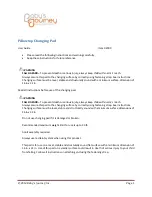
67
ISDN glossary
Gigaset CX100-150isdn / englisch / A31008-X150-G101-1-7619 / glossary.fm / 20.01.2004
Call waiting
CW, Call Waiting. Service provided by the network provider. An acoustic signal
during a call indicates that another caller is waiting. In addition, ISDN phones
indicate this with a displayed message. You can then decide whether to accept or
reject the second call.
Call waiting protection
Deactivates the call waiting signal.
Callback when the call is not answered
If a user does not respond when called, a caller can arrange an automatic callback.
As soon as the destination phone has completed a call and is free again the caller is
rung back. This service must be supported by the exchange. The callback request is
automatically cancelled after about 2 hours (depending on the network provider).
Callback when the number is busy
Callback must first be activated on the caller's terminal. A connection is established
automatically as soon as the destination phone is no longer busy. As soon as the
connection is free the caller is rung back. As soon as the caller lifts his receiver the
connection is made automatically.
Caller identification
Displays caller's phone number, name or type of connection (e.g., exchange/
internal) on the telephone screen.
Calls list
Depending on the setting, the calls list contains callers you haven't reached, or those
you have spoken to. The last 20 missed calls and the last 20 accepted calls are stored
with their phone number, date and time. If wished, you can return the call to these
users directly from this list.
CCBS (Completion of Calls to Busy Subscriber)
See "Callback when the number is busy"
CF (Call Forwarding)
See "Call forwarding"
Channel
Like an analogue connection, an ISDN connection enters the building through two
cables, but for ISDN a distinction is made between the two bearer channels called
the B-channels (which have nothing to do with the physical cables!) and the control
channel, otherwise known as the D channel.
CLI (Calling Line Identification)
The caller's phone number is transmitted.
CLIP (Calling Line Identification Presentation)
User A calls User B. A's phone number appears on B's telephone screen.
CLIR (Calling Line Identification Restriction)
Stops your personal phone number being displayed.
CNIP (Calling Name Identification Presentation)
User A calls User B. A's name appears on B's telephone screen.











































